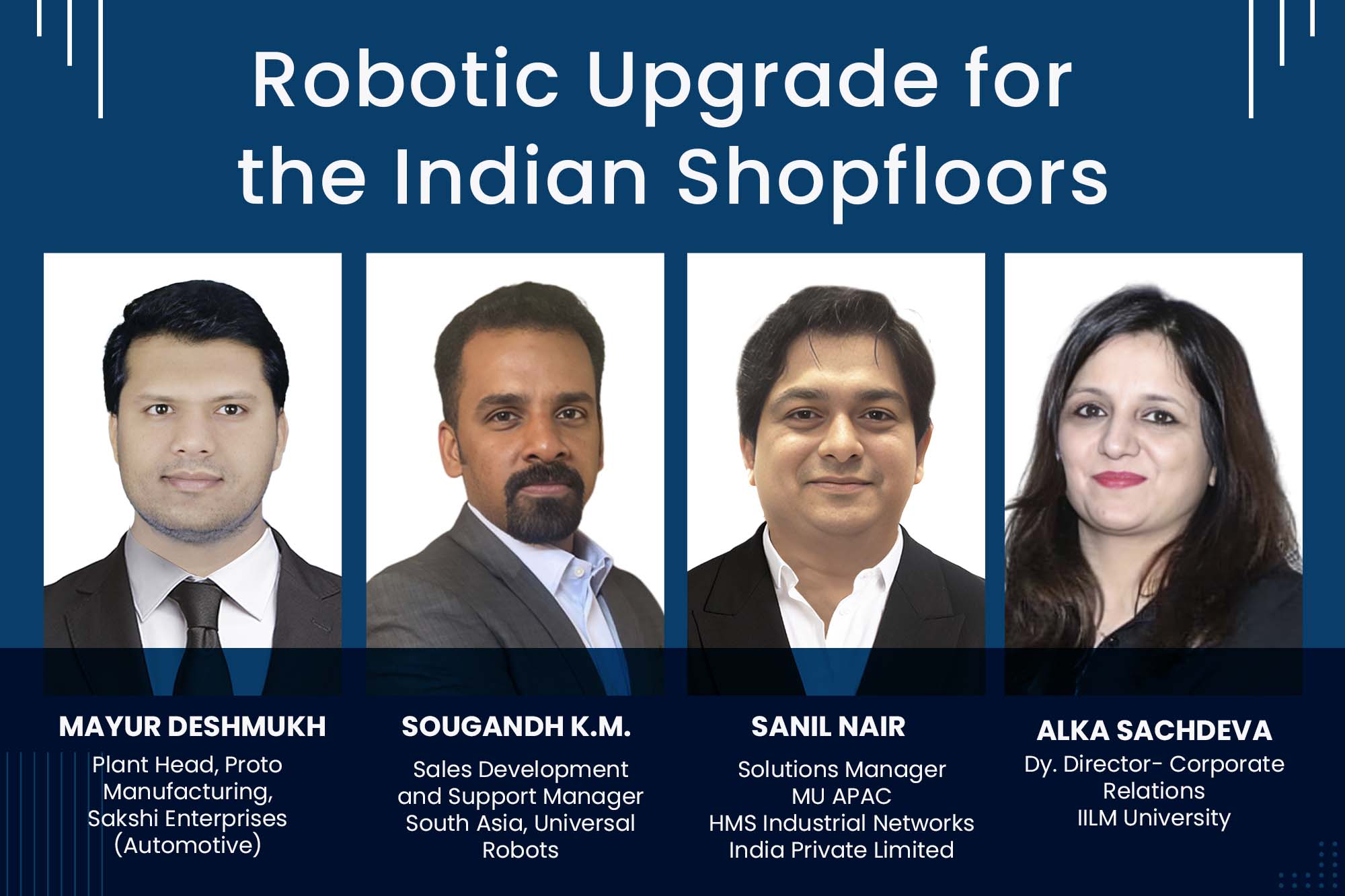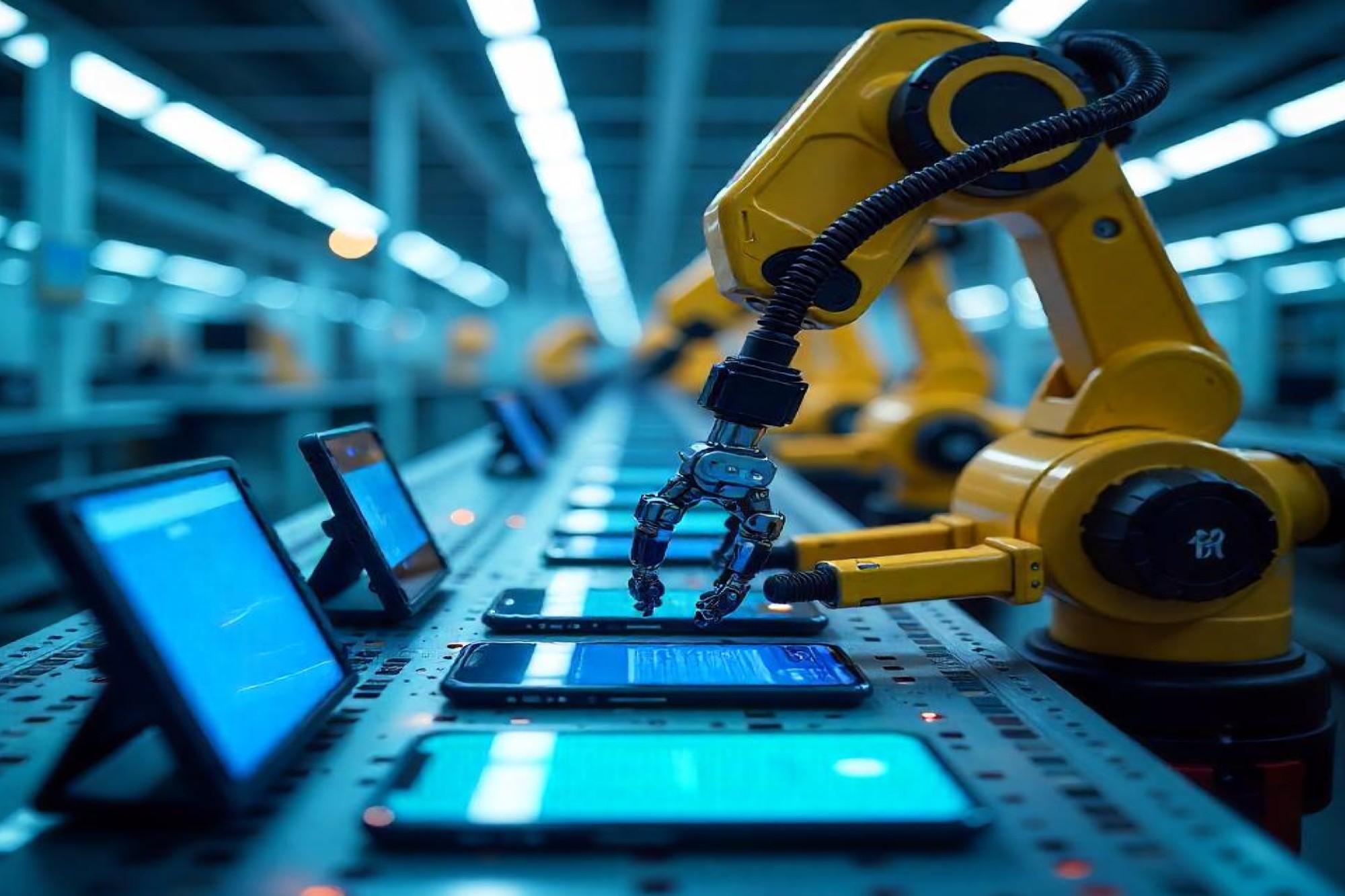Robotic upgrade for the Indian shopfloors
By Staff Report August 1, 2025 7:39 pm IST
The Indian shopfloor of the future will be a blend of human skill and intelligent automation. Robots and cobots won’t replace workers; they’ll work alongside them, reducing fatigue, improving precision and productivity. The shift has already begun, and we explore the effects of this shift with industry leaders in robotics in this article.
When my mom started experiencing back pain, perhaps aggravated by her constant need to clean the house, we decided to get a RoboVacuum cleaner. It cleans the house at a set time, doesn’t stumble upon any furniture or hurt its toes, and even goes back to charge itself. Pretty frugal buy for the value it offers. This made me realise that the owners of larger establishments like warehouses or a plant where oils and lubricants are packed must have exhaled a peaceful sigh when such auto cleaners were brought to the market.
Considering this, and while digging deeper along with a few industrialists who know the ins and outs of robots from making them, working with them, to promoting them to the likes of us, I tried to understand why robotics has gained so much prevalence and how it is suiting the Indian shop floor. Although it’s already suiting the Indian household pretty well, and I can vouch for that.
When to introduce robots and cobots?
So, at what stage should a user managing the shopfloor consider introducing cobots or robots? To this, Alka Sachdeva, Dy. The Director of Corporate Relations at IILM University says that analysing when to start your automation journey is crucial. Understanding when to adopt automation solutions, including the use of robots or collaborative robots (cobots), is essential, and it is always advised to do so in conjunction with your workforce. Alka shared a few key factors to consider:
Bottlenecks in manual processes: It may be time to consider automation when manual tasks become hurdles, such as in difficult-to-reach locations or repetitive, monotonous tasks.
Labour challenges: Hiring and retaining staff is increasingly becoming difficult. It can be due to hazardous working conditions or due to a lack of interest in repetitive tasks, and here robotics can be explored.
Quality assurance: When the user sees the cases of customer rejections rising or warranty claims, they should take it as a signal to implement automation to achieve consistent product quality.
Scaling production: If the demand for your product is rising, and you are planning to scale production, automation can help with operations and manage growth effectively.
Rising operating costs: When operational costs escalate and balancing these costs with rising demand is challenging, automation and robotics can optimise efficiency, reduce waste, and improve product quality, ultimately saving costs.
Shop floor space limitations: In small and medium-sized enterprises (SMEs) or micro, small, and medium enterprises (MSMEs), space limitations can be a significant barrier. Robots and cobots can help maximise the efficiency of limited space.
By analysing these factors, you can determine the optimal time to implement automation in your production processes.
What changes will they bring?
When planning to deploy automation solutions in your production process, the decision to introduce robots is significant. It represents a considerable transformation, and it is crucial to create a pilot project. Instead of automating everything at once, start with a small step. Identify one specific process that would benefit from automation and use it as your pilot project.
Secondly, understand the problem you want to solve before analysing potential solutions. Determine what part of the process you want to automate and plan it thoughtfully. Conducting thorough research will help to understand the problem clearly and find a suitable solution. Connect with consultants and study similar cases, keeping in mind the strength of your production.
Thirdly, select the right type of robot. There are many options available, including collaborative robots (cobots), industrial robots, and specialised bots designed for specific tasks. Consider the requirements for payload solutions, accuracy, quality of production, and the safety of your workforce. Once you’ve identified your problem, understand what kind of robot is necessary to achieve the desired output. Avoid overinvesting in robotics; assess your needs carefully before making a decision.
It’s also essential to collaborate with trusted local system integrators. Many solution providers and “Make in India” products can offer customised solutions based on your requirements. Familiarising yourself with the Indian market can help tailor these solutions effectively.
Involve and upskill your team during the deployment of automation solutions. It’s important to include those who will work with the automation tools, as well as managers and supervisors overseeing the transition, in discussions about how to implement automation.
Case Studies
Sanil Nair, Solutions Manager MU APAC at HMS Industrial Networks India Private Limited, shared a few lively examples illustrating how robots are performing at shopfloor operations. In Pune, where Sanil was involved in the installation process, the operators faced challenges handling hundreds of components daily, which were smaller than a ₹1.00 coin. Six to seven team members used two fixtures to pick and position these small parts, but the repetitive nature of the work led to fatigue; production dropped from about 800 components at the start of the hour to around 600 or 650 by the fifth or sixth hour. Recognising the benefits of a collaborative robot, Sanil’s team installed one that uses a vision system to assist with the task, working alongside human operators without barriers.
The second example involved the automotive industry, specifically in glass glueing systems. Robots are typically required to affix windshields to vehicles, often needing significant infrastructure. In one installation, a cobot was mounted upside down to save space, applying glue to the glass while operators lifted and positioned it onto car bodies.
In the FMCG sector, robots now assist with palletising finished products. After packaging, heavy boxes must be lifted repeatedly, which can be physically taxing. Sanil shared that their team installed a robot that works alongside operators, picking up boxes from the conveyor and placing them on pallets for shipping.
Current scenario of robotics in India
India, like many Southeast Asian markets, adopts technology slowly, often lagging behind regions such as Germany, the US, Japan, and Korea. Sougandh K.M., Sales Development and Support Manager, South Asia at Universal Robots, thinks that one reason for this delay is the abundance of labour in these areas. We believe we have a highly intelligent workforce, which raises the question: Do we need automation to solve our problems when our people can do it? Removing human workers is not always the best solution, and simply introducing robots will not solve these issues. We need to balance human intelligence and robotic automation.
The slow adoption of these technologies is partly due to a lack of knowledge and expertise in the region. There is a shortage of skilled mechatronics and mechanical engineers because the halo around software technologies is too bright. This trend could lead to a future without engineers capable of working in factories. We must reconsider our education system because imagine if we had eliminated software from the curriculum 25 years ago, then India would have missed the software boom. Similarly, we should reintroduce mechanical engineering, electronic engineering, mechatronics, and related fields such as AI and machine learning. Collaborations with foreign universities could improve our curriculum and better prepare students.
In 10 to 15 years, today’s students will apply what they’ve learned. Without education in robotics or automation, they may struggle to implement innovative solutions and may only replicate foreign practices. Thus, introducing relevant subjects and cultivating a skilled workforce will go a long way.
Market leaders in industrial and robotic automation, such as ABB and Universal Robots, are developing technologies outside of India. Companies like Rockwell and Siemens are leading this development, resulting in India adopting these advancements later through imports. China produces hundreds of thousands of industrial robots annually, while India lacks the necessary supply chain and economic viability for such mammoth production. Currently, India is focused on adopting technology from countries like Germany and manufacturing locally. However, we need to shift towards innovating and creating solutions tailored for the domestic market rather than primarily targeting the U.S. market.
Manufacturing of robots
Manufacturing of robots is primarily driven by the demand posed by the industry, segment-wise. India is going strong in automotive, pharmaceuticals, and the food and beverage sector, and we’re gradually moving into the electronics sector as well. In these sectors, there is a real need for tailored robots rather than generic robotic arms, allowing for better scalability. A collaborative robot (cobot) that excels at palletising or one that handles end-to-end assembly in electronics would be fantastic.
However, we haven’t started mass manufacturing these specialised robots, and our challenge lies in achieving scale. We aim to learn from other regions to adapt their technologies for local needs. Significant changes are also needed in the supply chain to perceive real progress. If we succeed in developing solutions in India, we can apply them globally. This market is challenging to penetrate, but if we succeed, it will be rewarding, as per Sougandh.
Another aspect is prototyping, which is essential in robotics development as it helps teams to identify design flaws and production challenges early in the process. Mayur Deshmukh, Plant Head, Proto Manufacturing at Sakshi Enterprises (Automotive), points out that the prototype phase helps uncover the real problems and potential risks of the product. This helps engineers and designers to work closely together on timely modifications. This early feedback loop ensures that issues such as tool accessibility or robotic arm movement are addressed before full-scale production, reducing both risk and costs on the shop floor.
Future Indian factories
The future of the Indian factory floor is set to become highly digital and data-driven. We might see semi-autonomous or even fully autonomous systems in certain sectors within the next decade. Predictive maintenance, real-time performance monitoring, energy efficiency, and operational productivity will be key areas where artificial intelligence (AI) and Internet of Things (IoT) systems will inform decision-making. Ideas like digital twins, edge computing, and remote diagnostics will become standard.
Given the rapid pace at which technology is being adopted, and with trends toward Industry 4.0 and the emerging discussions around Industry 5.0, traditional manufacturing practices, especially in MSMEs, will likely shift away from individual decision-making on the shop floor. Instead, we can expect a more integrated approach, where decisions are driven by real-time data and analytics provided by AI and IoT.
Cookie Consent
We use cookies to personalize your experience. By continuing to visit this website you agree to our Terms & Conditions, Privacy Policy and Cookie Policy.















